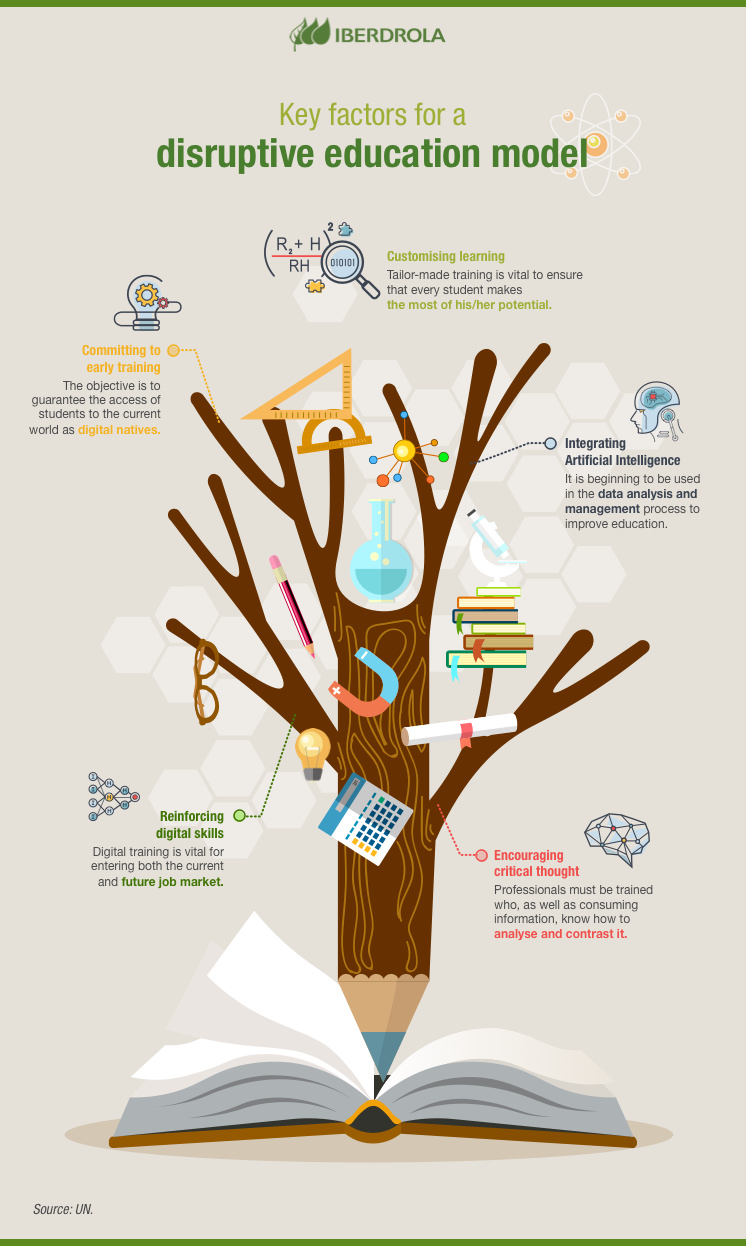What is disruptive education?
Disruptive education for meeting the challenges of the future
Digital talent High performance Professional skills
Innovation is one of the watchwords of the 21st century and training must form part of this (r)evolution in order to bring it into line with the demands of an increasingly hyperactive and hyperconnected world. In order to meet these challenges, technology is an essential ally when promoting a disruptive form of education that puts learning in a new light.

A disruption is a sudden break or interruption. Disruptive education is, therefore, that which intends to break with the established model to improve the existing one. And many experts think the change is both necessary and urgent because the current system is anachronistic, in other words it is still anchored in the last century and is failing to address the needs of the digital age.
This is what, Ken Robinson, among others, believes. This Briton, one of the best known figures in the world of education, has repeatedly pointed out that while economic, cultural and personal areas have undergone an enormous transformation over the last 50 years, our education systems have not modified their syllabuses and their objectives a jot.
Curtis Johnson, co-author of the bestseller Disruptive Class: How Disruptive Innovation Will Change the Way the World Learns, explains that the current form of teaching "is unable to provide today's pupils with the skills they need to master in order to interact with and within the digital society". He then goes on to highlight the need for a disruptive education that approaches learning in another way.
The challenges facing education in the 21st century
No universal agreement exists regarding the challenges facing education in the 21st century, but they are being partially addressed by reports such as 2018 Higher Education Edition compiled by the US Group NMC Horizon. This document describes a number of global objectives such as, for example: customising education to adapt it to the needs and strengths of each pupil, training professionals who are, at the same time, members of the public and, of course, equip the students with the social and technical skills and tools demanded by the job market.
How can this be achieved? The answer lies in innovation. Innovative approaches, innovative methods and innovative formats. What we are talking about here, for example, is Artificial Intelligence (IA), gamification — which is being so well received in the classroom as an effective way of getting pupils to study using game — design elements in non-game contexts —, teachertubers, MOOCs — massive open online courses —, lifelong learning, business e-learning and all the other possibilities that educational technology offers.

The university's role in disruptive education
The world is currently moving at lightning speed that requires curious, flexible and proactive people. This, in the case of education, cannot only apply to teachers and pupils, but also to institutions such as the university. Historically, universities have moved slowly and had problems adapting themselves to changes, but they are currently going through a disruptive period marked by the following milestones:
Practice over theory
Universities are increasingly concentrating their efforts on the acquisition of skills and abilities adapted to the new reality rather than to concepts.
Multidisciplinary learning
The frontiers between disciplines no longer exist. Therefore, training must be adapted and content-rich so as to create professionals with a far reaching vision.
Digital innovation
Around 800 universities now have their own virtual areas for training, partnership and shared knowledge purposes.
Closer links with the job market
The trend is for universities to become platforms for connecting companies and students and promoting the entrepreneurial spirit.
Making competitiveness a priority
Universities must be ever more competitive in order to transform themselves into research leaders and new knowledge areas.
Disruptive innovations in education
Although little mention is made of Artificial Intelligence in the world of education, the truth is that projects in this area have been implemented over the last few years. One example of this is Capaball, a start-up company that has developed the first ever Artificial Intelligence system that creates training programs tailor made to match the student's profile. The idea came about as a result of the acknowledgement of two realities: that current education is not meeting the challenge laid down by the digital revolution and that the majority of graduates enter the job market unprepared.
But this is not only being done by companies. From the purely educational side, universities such as Denmark's Kaospilot, the USA's Minerva or Sweden's Hyper Island have been putting disruptive educational approaches into practice for years. For example: daily content renewal, real projects with companies, no more predefined syllabuses, trial and error learning instead of exams and master classes, learning based on pupil and teacher experience, methodologies designed to make the most of leadership and entrepreneurship, etc.
Another disruptive concept is the hyper-classroom, a type of learning area that could replace the traditional model. This is an innovative space characterised by three ideas unified by the prefix 'hyper': hyperspace, generously sized, open and flexible spaces that can be rearranged to cater for team or individual work; hypermedia, classrooms in which technology constitutes an environment in its own right and does not merely play a supporting role; and, finally, hyperreality, the use of augmented, virtual, 3D or immersive reality with high teaching potential.
Online or face-to-face training, which to choose?
Nanodegrees, online courses that will change your life
Women and STEM disciplines: a question of gender
Disruptive talent: how thinking out of the box could improve your organization




